Simple Question #9 - How Animals See the World? Do They Experience the Same World?
So how are you my fellow steemers? I am here again with another interesting and thoughtful Simple Question: How animals see the world? Do they see the same word that we see? You may have thought about this question at some point in your life? Even if you were busy and didn't ever think about it, still you can read this post to enhance your understanding about this world. I shall not tell much about the topic here but one thing I can say, you will be shocked with the answer.
This post is going to be a bit long, so if you're standing then please seat comfortably in your couch and start reading. 😄
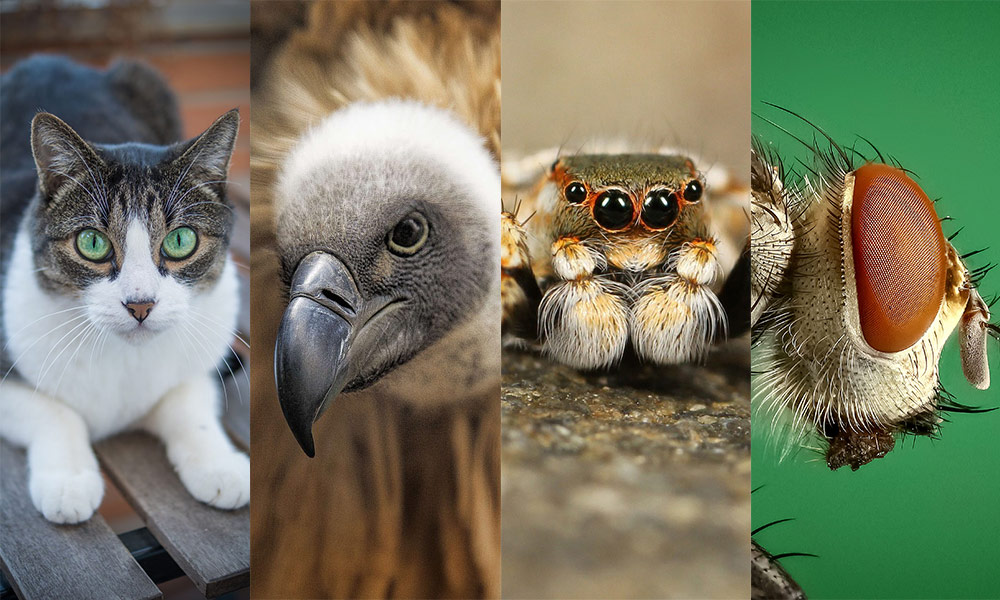
We share this world with a variety of organisms from simple to complex life forms. They all are different in their features and capabilities. But do they experience the same world that we experience? Probably no. Every organism has different sense organs, very much different from ours and sees the world from its own perspective. Different animals and birds have got different types of eyes with different image processing capabilities. While some animals are color-blind, others can see the world in more detail than us. Some animals can see those color with we can't and some can see the world in slow motion. So, our eyes may be good in some aspects but there are some animals whose vision excel ours.
Our visual perception of the outside world depends on how our eyes process light. Humans are trichromats – means that they have three types of photoreceptors known as "cones", which can observe the colors red, green and blue. There is yet another type of photoreceptor cells present in our eyes called "rods", which can detect small amounts of light; they help us to see things in the dark. Animals process light differently – some have only two types of photoreceptors (cones), which make them partially color-blind, some have four types of cone cells which enable them to see the ultraviolet spectrum of light and others can even detect polarized light i.e. light oscillation in the same plane. Some animals have a higher number of rod cells which enable them to see more clearly in the dark. Some birds have binocular eyes which can see minute objects miles away.
Thomas Cronin, a professor of visual philosophy at the University of Maryland, says:
"None of us can resist thinking that we can imagine what another animal is thinking." [1]
While speculating what animals are thinking is a fantasy, viewing the world through their eyes is quite possible. We can do that by analyzing the properties of animals' visual systems by the use of some advanced equipment.
So, how our favorite pets (cats, dogs etc.), birds, insects and aquatic animals see and perceive this vast and beautiful world? Let'sanalyzee their visual systems and other connected sense organs to find out.
Dog Vision

Human View (Left) - Dog's View (Right)
Unlike human beings, dogs have only two types of cone cells so they don't see much variety of colors that we see. Their cone cells are sensitive to blue and yellow but not red and green. Their vision can be compared to a person who is color-blind. However, the popular belief that dogs can only see in shades of grey is simply not true. They can see blue and yellow and are less sensitive to shades of grey.
Also, their resolution of vision is lower than human beings. So, probably they cannot read the fine print on the newspaper. However, they can read the headlines. 😄 Human vision is among the sharpest of all animals, thanks to the tightly packed cones at the center of our retina. Again dog's range of seeing objects clearer is around 6 meters whereas humans can see up to 23 meters.
But we cannot underestimate our little canine friend because of these limits. Dogs have a wider peripheral vision than ours. So they can see a much wider space at the time which helps them to protect themselves from possible threats around. Their limited sense of vision has empowered their other sense organs. They have heightened sense of smell and a more sensitive ear which counters all the limits in visual system.
Cat Vision

Human's View (Top) - Cat's View (Bottom), also notice area of Peripheral Vision | Wired
Dan-Eric Nilsson, a zoology professor and co-author of the book, "Animal Eyes", says:
"We will never know what a cat would experience." [2]
Like dogs, cats are also dichromats; they also have only two kinds of cone cells. Cats are also color-blind to red and green. To replicate a cat's vision, one has to pool everything that is red or green into one color.
Cat's eyesight also has a lower resolution due to which they see objects slightly blurred than we do. Although they have a blurry vision in the daylight, they have a sharper vision in the dark, thanks to the more amount of rods in their eyes. Also, cats can pick up quick movements more easily than humans. While humans have 180° of field of vision, cats visual field spans a whopping 200°. Also, cats have a larger peripheral vision.
So it turns out that, although cat's vision is limited, it does surpass human eyes in some aspects.
Snake Vision
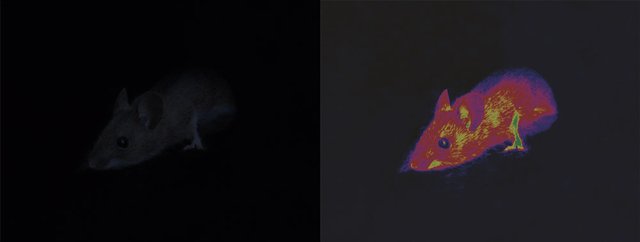
Human View (Left) - Snake's View (Right) | Nautilus
Snake vision varies wildly from snake to snake. Most of them have a low-resolution color vision during daytime and have a plenty of rod cells for sharper vision at night. Although they have a blurrier vision in the daytime, they can easily detect quick movements. So it's better not to make a quick awkward movement when a poisonous snake is in front of you.
But what makes their vision special is their ability to sense infrared light. Most of the snakes, like viper, rattlesnake, python and boas, can detect heat signatures. They have special sensory tools called pit organs – a pair of holes on either side of the snout between the nostril and the eye. These pit organs are able to detect infrared light (heat signatures) which are then converted into nerve signals and reach the brain.
Snake's brain merges the heat signals coming from pit organs with information from eyes so that prey's thermal image in overlaid over the visual one. However, we can easily get an idea what a snake sees by looking through an infrared camera.
Fish Vision

Human View (Left) - Fish View (Right) | ZME Science
Fish eyes have both cone and rod cells. They can see different colors just like humans. Some can even see ultraviolet light and some are sensitive to polarized light.
Although the eyes of fishes are similar to that of vertebrates, they have a more spherical vision. [You may have seen fish eye effect in your digital camera.] Some deep-sea fishes have a larger number of rod cells which help them to see clearly in the dark.
However, there are some fishes like sharks which can't see color. They see only in shades of grey, but clearer inside water.
Cuttlefish Vision
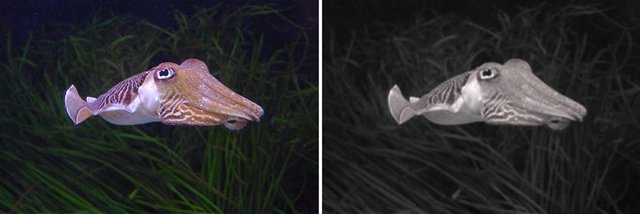
Human View (Left) - Cuttlefish View (Right)
Seeing through the eyes of cephalopods such as octopus, squid or cuttlefish require a high range of imagination, as these sea creatures have evolved their eyes in the ocean separate from the vertebrates. For example, cephalopod eyes have no blind spot, and the pupil of a cuttlefish is shaped like a "W" making it look like an alien organism.
Despite being an expert hunter, cuttlefish have a blurrier vision than humans. Although they have incredible color changing skills (they can change the color patterns on their skin with a blink of an eye), they are totally color-blind. Their eyes have one photoreceptor that let them see in shades of grey.
They still have another pair of photoreceptors which detects polarisation of light. They can easily detect lights polarized in different orientation separately. Cuttlefish also produce polarization patterns on their skin which other Cuttlefish can easily observe through their vision. This may be a method of communication among them. Looking at one another they will see shades of grey with the polarization information overlaid, just like how snakes see the infrared information.
Snail Vision

Human View (Left) - Snail's View (Right)
Different types of snails have different types of eyes and visual capacity. As most snails are small it is difficult to see their eyes. But most of the land snails do have eyes. They are present on the top of the tallest pair of tentacles present on their head. The position of eyes also gives them a wider frame of vision.
On the other hand, sea snails have eyes in entirely different position. Rather than sitting on the tips of the tentacles, the eyes of sea snails are located at the base. Their eyes are locked in a position (just like humans have their eyes locked at the center of their face) and cannot move their eyes to see around like land snails. They are not yet another type of snails which don't have eyes at all. These type of snails normally belong to the category of underground snails. However, it doesn't mean that without vision they cannot move and perceive the environment. They can easily navigate their habitats through their sense of smell and touch. [3]
Actually, snails don't rely on vision as much as humans, but it's still one of their senses. Their eyes are very much primitive. They can neither see color, nor focus on objects. Their vision is very much blurry; they can just make out whether another snail is moving past or a predator is approaching. However, snails can observe different intensities of light which help them to navigate towards dark places.
Bird Vision
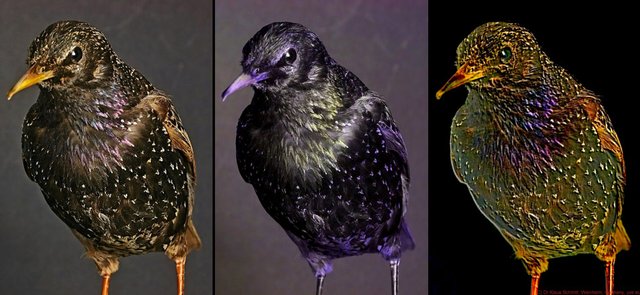
Human Vison (Left) - Reflected UV (Center) - Simulated Bird Vision (Right) | Credit: Dr. Klaus Schmitt, Germany
Vision is the most important sense for birds since a good eyesight is compulsory for a safe flight. So eyes of birds have evolved much and are superior to other vertebrates. Unlike humans, birds are tetrachromats – as they have four types of cone cells which enable them to see red, green, blue and ultraviolet simultaneously. Some of them have much sharper vision than humans, thanks to the presence of high-density cone cells in their retina. A large Eagle can see 2.5 times the resolution that we do. It can spot a rabbit 3.2 km away! What a telescopic vision!
Even a pigeon sitting on the top of your house can see details and small cracks on the road which you can't.
So, birds have a very clear and sharper vision, and their ability to sense ultraviolet light adds more detail to their sight. Some birds like owls have an ability to see clearly even in the dark.
Spider Vision

Human View (Left) - Spider's View (Right) | Natural History Museum
Spiders (especially jumping spiders) have an excellent vision through their eight eyes. The biggest pair of eyes face forward and have a sharp high-resolution vision. The remaining six eyes are used for peripheral vision and movement detection.
Their larger pair of eyes has the ability to detect even the ultraviolet light with high sensitivity. So, they can see much detail in flower petals, that we can't. Jumping spiders have special filters in front of the cells of their eyes which enable them to see a broader spectrum of colors. These features of vision make them great hunters.
Fly Vision
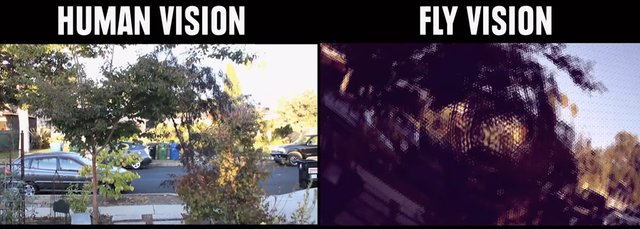
Human View (Left) - Fly's View (Right) | ZME Science
Flies (common housefly, Musca Domestica) have the fastest visual response in the animal kingdom. They look at the world in a quite different way than humans do. They have compound eyes – each eye is made up of thousands of small individual visual receptors called ommatidia. Each ommatidium is a functioning eye in itself and all the ommatidia together provide a broader field of vision. The eyes of flies protrude outwards which provide them a close to 360° of peripheral vision.
As they have a compound eye, their vision is more or less pixelated. You may compare it to a mosaic effect. The clarity of vision in a compound eye depends on how many ommatidia are present in each eye. Also as they have a compound eye which is basically fixed and all the photoreceptors are locked, a fly cannot focus on objects like us and cannot see farther than a few yards. [4]
Although they have a blurrier vision than us, their vision is up to five times faster than humans in tracking movements. They see the world in a much higher frame rate and maybe that's why they easily escape power attack with a folded newspaper. Wow! they have a super cool slow-mo eye!
Flies have limited color vision as they have only two types of color receptor cells. However, they have the ability to see polarized light.
Bee Vision

Human Vison (Left) - Simulated Bee Vision (Right) | Credit: Dr. Klaus Schmitt, Germany
Bees also have compound eyes like that of flies. Their eyes have extremely low-resolution. Because of that, they have a blurry vision.
Like humans, these are also trichromats but instead of red, green and blue, their three types of photoreceptors are sensitive to yellow, blue and ultraviolet light. Their ability to see ultraviolet light help bees to spot pattern on flower petals that guide them to nectar.
Vision of Mantis Shrimp
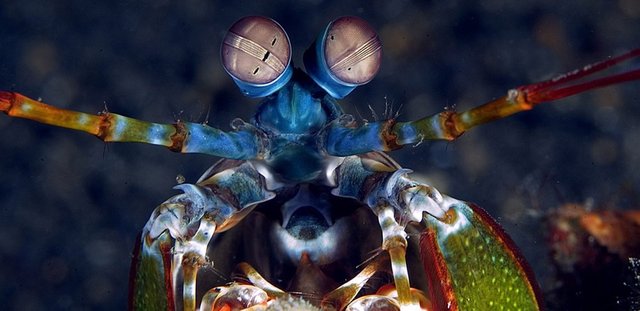
Mantis Shrimp with 16 Photoreceptors | Credit: DiverKen, Phys.org
Mantis Shrimps have the most complex visual system known to any animal. They have a whopping 16 photoreceptors compared to human's three. They can detect all UV, visible and polarized light. In fact, they are probably the only animals that can detect circularly polarized light – when the wave component of light rotates in a circular motion. These features of vision enable them to distinguish between two similar colors and give them an enhanced ability to see details in everything under water.
Mantis Shrimps also have compound eyes like flies but have a better vision. In the species of Mantis Shrimp having a spectacular vision [Gonodactylids and Lysiosquillids], the middle of the eye has 6 rows of modified ommatidia called the mid-band. This is where the actual magic happens. The first 4 rows are specialized ommatidia to detect human visible light and UV light. Each row contains a different receptor in the UV range, which gives a Mantis Shrimp extremely good UV vision. The last two strips are most likely responsible for their vision of polarised light.
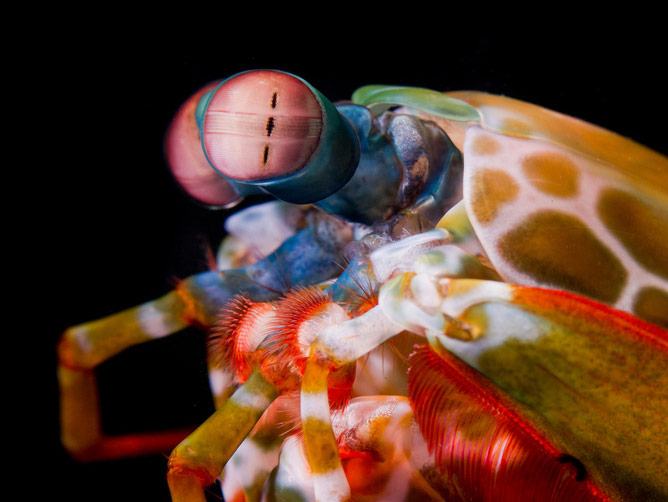
Eye of Mantis Shrimp, Notice the Mid-bands | Credit: Michael Bok, Phys.org
The overall structure of the eye of Mantis Shrimp is also incredible. They can perceive depth with just one night and can move another one independently to have a large field of view. [5]
Also, Mantis Shrimp can create polarization pattern on their bodies like Cuttlefish. The only difference is that Mantis Shrimp can also use circularly polarized light. This is probably used for visual communication and attracting mates.
After reading all this, we can say that what a Mantis Shrimp sees is impossible to imagine, but incredible to think about.
Conclusion
These fantastic visual abilities of animals do challenge our superiority and make us aware of our limits and incapabilities. There is so much in the world that we can't perceive. There are incredible possibilities in animal vision.
This makes me think about other crazy possibilities. Pardon me for going to the philosophical way. Maybe we lack some sense organs and because of that, we are completely unaware of many things happening around us. Imagine a creature that doesn't have any eye or ear, will it ever be able to know whether light or sound exist? For us, that creature's experience of the world is very much limited. And that creature will never be able to know something like humans exist.

The hidden Alien World which we can't perceive
What if our sense organs are primitive for some superior species. Maybe some alien species are around us but we cannot perceive them because we lack the required sense organs. Maybe our Illusion of ghosts is probably some interaction with some superior alien species. Who knows!!
Thank you so much for giving your time to read this long post. Hope you enjoyed reading it. 🙂
If you have any thoughts or want to criticize my "sense organ philosophy" don't forget to leave a comment. 😉
If you find this post useful and informative don't forget to give an UPVOTE and a RESTEEM.
You May be Interested in this Video:
Image Source :
All the non cited images are from Pixabay.com, Pexels.com, or Wikipedia.com and are available for Reuse under Creative Commons Licenses.
References
[1] - http://nautil.us/issue/11/light/how-animals-see-the-world
[2] - Animal Eyes: Michael F. Land, Dan-Eric Nilsson
[3] - http://animals.mom.me/snails-eyes-10446.html
[4] - http://animals.mom.me/flies-see-out-compound-eye-5361.html
[5] - https://phys.org/news/2013-09-mantis-shrimp-world-eyesbut.html
[•] - http://www.nhm.ac.uk/discover/how-do-other-animals-see-the-world.html
[•] - http://thinknitesh.com/how-animals-see-world/
[•] - https://www.zmescience.com/other/feature-post/animal-vision/
Previous Episodes of the Series
- Simple Question #1 - Why do we Dream? What is its purpose?
- Simple Question #2 - What is Life? Why does it exist at all?
- Simple Question #3 - How big is the Universe? What is its Shape?
- Simple Question #4 - Should we eat Meat? Why and Why Not?
- Simple Question #5 - What is Time? Will it ever stop or reverse?
- Simple Question #6 - Do we all feel Time the same way? Can we travel back in Time?
- Simple Question #7 - What is Space? Is It Really a Static Infinite Void?
- Simple Question #8 - Does Space have any overall Shape? Is it Quantized?
Follow me @nitesh9



--- thinknitesh.com ---
Wow...Amazing Post...its a treat to read your posts.
P.S. i feel sorry for snail, poor guy has motya-been (Cataract).
Thanks bro. 😊
Yeah, poor snail. Some are even blind. But they don't care about that, they think that is the only world. 😄
If you are interested you can make use of the steemiteducation tag so we can resteem your posts.
Will surely take care of that from the next time. Thank you so much for supporting. 😊
Fascinating information and fun comparison. Another thing that is quite interesting is the tapetal reflex of some animals. Canids and Felids will show those creepy "glowing" eyes when caught in the headlights of a vehicle. This is a shiny reflective layer beneath the retina, the tapetum lucidum, that allows light entering the eye and passing through the retina to be reflected back to hit the retina a second time, further enhancing their night vision. Our eyes, in contrast, give the classic "red eye" (that our cameras now try to prevent or correct for) because we haven't a reflective tapetum, and instead, the flash of a camera may actually illuminate the vascular surface of the back of our eyes, giving the red appearance.
Really Very Interesting Article!! I simply love your articles, what great content and quality of posting you offer the community here on Steemit and abroad.
Thanks a lot :)
Thank you so much bro. :)
Could have broken this into two parts at least!
I read somewhere that this, referring to dogs, may not actually be true anymore. Our smell may be just as good but focuses on different things. You'd have to check that out though I can't remember where I read it!
Good read!
Really didn't know about the recent findings.
However, if anyone has one defective sense organ, his/hers other sense organs get improved, maybe because they use those organs more. Possibly same thing is happening in dogs.
The Mantis Shrimp is one amazing little creature. I am sure you also read that they have a really powerful hitting force, actually able to produce the force of a .22 caliber bullet. I love those little guys.
Yeah, they are super powerful. Their kick actually creates a vacuum bubble in water with very high temperature inside (heard somewhere that it is close to the temperature of the surface of sun!).
It is really astonishing, that such a small organism has so many incredible capabilities.
Informative and interesting post.Keep it up bro!
Thank you so much bro. :)
Nice post....I've always thought of this....But you've cleared my doubt now...Thank you..
Thanks for stopping by. :)
wow,wonderful
Nice post! Interesting stuff about the shrimp. So much more than just a little blob of food for bigger fish. This post really reminds me of an experiment I did to disprove the theories of the speed of light and sound. One of the tests was to gather a different numbered group of dogs multiple times, and during a thunderstorm record their reactions to the sound and compare those reactions to those of humans.
It seems that we've created these flawed scientific laws based only on our perspective with no further research. Truly sad.
I am happy that you liked it. :)